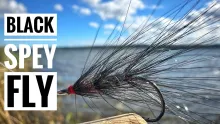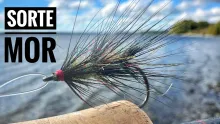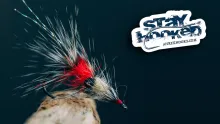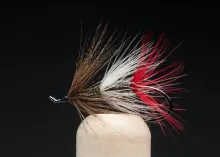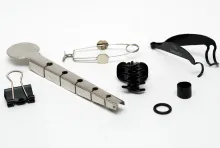With over forty years of experience behind him, and a flock that's almost a half a century old, Dennis Conrad knows how to grow hackle. GFF Rating: 5
With over forty years of experience behind him, and a flock that's almost a half a century old, Dennis Conrad knows how to grow hackle.
GFF Rating: 5
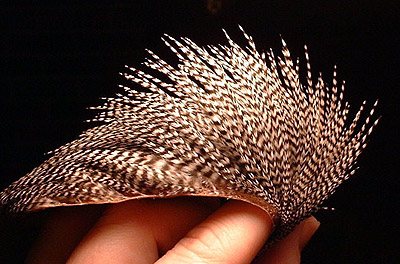 Everyone's heard of "you-know-who" and his hackle. However, not everyone has heard of Dennis Conrad and his hackle. My intent is not to compare hackle brands or pass judgement on what is "the best". Such determinations cannot possibly be made in any sort of subjective way, because every tyer has their own opinion on what is important in hackle. With some, it is the number of hackles that will wrap tiny tiny flies. With others, it is the color of the hackles. Still others will go with barb density, or number of feathers per patch, or the length of the average "sweet spot". What I will not do is try to gauge these hackles based on "number of flies tied per patch". That's an interesting number, but not one that I care much about. Value is something that needs to be determined by each buyer.
Everyone's heard of "you-know-who" and his hackle. However, not everyone has heard of Dennis Conrad and his hackle. My intent is not to compare hackle brands or pass judgement on what is "the best". Such determinations cannot possibly be made in any sort of subjective way, because every tyer has their own opinion on what is important in hackle. With some, it is the number of hackles that will wrap tiny tiny flies. With others, it is the color of the hackles. Still others will go with barb density, or number of feathers per patch, or the length of the average "sweet spot". What I will not do is try to gauge these hackles based on "number of flies tied per patch". That's an interesting number, but not one that I care much about. Value is something that needs to be determined by each buyer.

A pair of Conranch dry fly necks.
Griffith's Gnat
California Mosquito
Parachute Hare's Ear

Conranch Dry Fly Saddle
Stimulator
Foam Humpy

Conranch saddle hackle and size 18 Tiemco TMC100
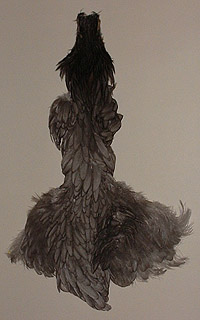
Medium Dun JV Hen Skin
What I will talk about are the quality of the hackles. The way they tie. I will discuss the range of sizes found on necks and saddles. I will talk about how the hackles behave when palmer wrapped, parachute wrapped, and wrapped in a traditional "Catskill" fashion. I will talk about the colors, the barb density, the "sweet spot", and all the other attributes that fly tyer's will
consider when choosing hackle. When all is said and done, you might be surprised with what such a small-scale hackle breeder can produce.
Dennis has been raising birds for over 40 years. What started out as a project to earn him a merit badge in scouts has become a business that he and his daughter Liz run together, just the two of them. His ranch produces upwards of a thousand products per year with a near term goal of about 1500, which is just where he wants it. Any more and he would have to hire out for help, which he would like to
avoid. He enjoys it being just Liz and him.
The Conranch line of hackle is from a flock of birds that has been bred for their dry fly hackle for almost a half a century. The colors are all natural - from rich blacks through cream and gingers, to bright grizzlies. In addition to dry fly necks, his birds also produce excellent dry fly saddles. He also has brought onto the market a line of hen products specifically targeted toward hackle tip
dry fly wings.
Dry Fly Necks
Conranch sells hackles and necks separately. The necks have a good range of hackle sizes from smaller than I will ever use (in the 20's) to a usable size 8. The meat of the neck is in the 12-20 range, which is perfect for most applications. To learn more about these hackles, I chose three flies that I thought represented typical uses of dry fly neck hackles - a parachute, a conventionally hackled fly, and a palmered. Using his grizzly hackle, I tied a parachute hare's ear, a California Mosquito, and a Griffith's Gnat.
The mosquito was a good test, because what I've found in using other genetic dry fly hackle is that good tailing materials has been sacrificed for longer and thinner hackles. I have some old necks that have wonderful wide hackles that would be found on the throat of the rooster. These have long, shiny, stiff barbs that produce excellent tails on a conventionally wrapped fly. I was pleased to discover some nice tail hackles on the Conranch hackle.
I was able to easily tie the three standard fly styles with no problems. The stems of the hackles were thin and flexible and did not show any desire to twist while the hackle was wrapped. The parachute hackle was nice and flat, and the double wrap of hackle on the mosquito fell into place very nicely. There was plenty of length to palmer the Griffith's Gnat. In short, I found the neck to do exactly what I would expect it to do.
Dry Fly Saddles
Everyone is going nuts for dry fly saddles these days. As far as I knew, there was only one breeder producing what I would consider true dry fly hackle on a consistent basis. The Conranch hackles I was able to review provided a good mix of true dry fly quality hackle as well as some very webby "schlappen" style hackles. From the same patch, I could pluck a ten inch long feather that was a perfect size 18 dry fly hackle, and I could put a seven inch long feather that was solid dense web in a beautiful iridescent black that will produce fantastic woolly buggers or other wet flies.
I'm not one to worry about how many flies I can tie from a single feather. What I care more about is being able to tie good flies with the feathers I have to work with. The type of flies I would tie with a dry fly saddle would mostly be palmer bodied dry flies like an Elk Hair Caddis or a Stimulator. Since the stems of dry fly saddle hackles are so thin, you can wrap an extraordinarly dense hackle collar, which is great for "western" style dry flies such as a Humpy or a big Wulff-style fly. With these flies, meant to be fished on the surface of very turbulent water, the more wraps of hackle you can pack into the space available, the better. As such, you are better off using saddle hackle. The barb density on a good dry fly saddle hackle usually is higher than an equivalent neck hackle, and since the stems are thinner, you can usually make the wraps tighter and closer together. For the purposes of this review, I tied a Stimulator and a Foam Humpy, to test the qualities of the Conranch saddles What found was impressive. As I expected, I was easily able to tie a Stimulator.
I mean, with a ten inch long hackle, if you can't palmer a stimulator body, something is wrong. The hackle palmered well, did not want to twist, and projected nicely from the dubbed body. I had plenty of hackle to spare. The Humpy went equally well. I was easily able to pack a ton of hackle around the wings. I figure this fly will float forever.
J V Hen Skins
Dennis is rightly proud of these hen skins. They are bred to serve as dry fly wings on traditional dry flies. Each skin comes with a complete neck and saddle patch. These are called "J V" because they are not yet mature birds. Taken early in their growth, the neck hackles especially are nicely shaped for wings, with rounded points and a nice web line. The saddles show feathers with solid web that will produce excellent soft hackle wet flies or even can be used to make cut wings for more realistic dry flies. You can't find these hackles elsewhere. Most hen necks have hackles that are long and thin, with pointed tips and relatively little web, another by-product of breeding for dry fly hackle. Dennis understands what fly tyers want, and he produces hackles to satisfy those needs.
- Log in to post comments

